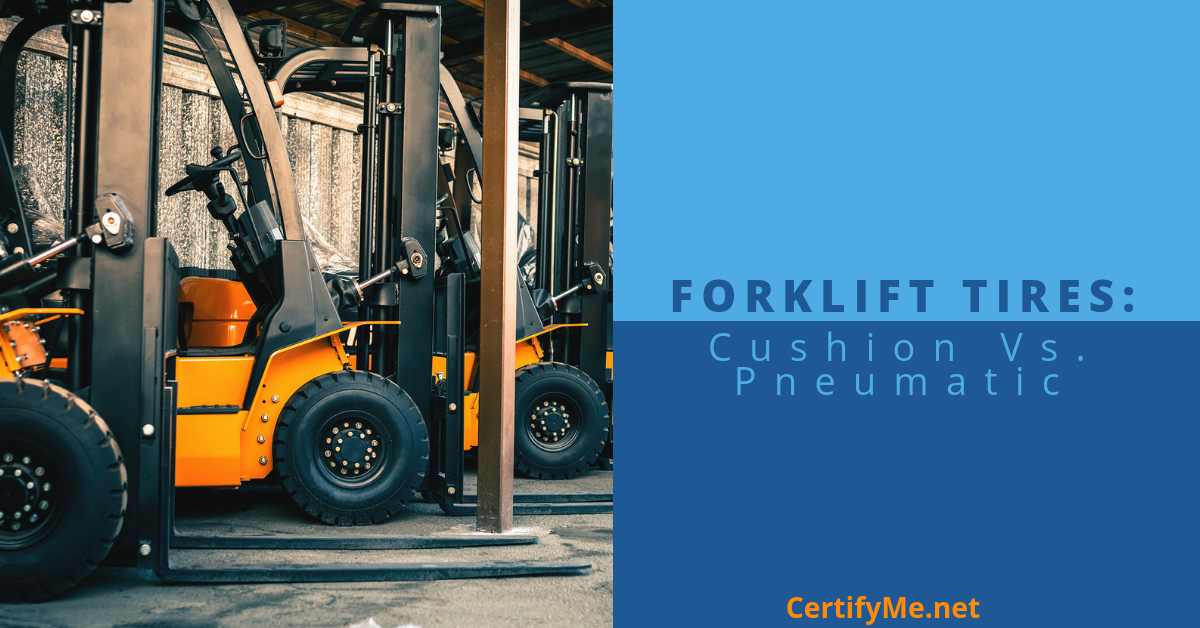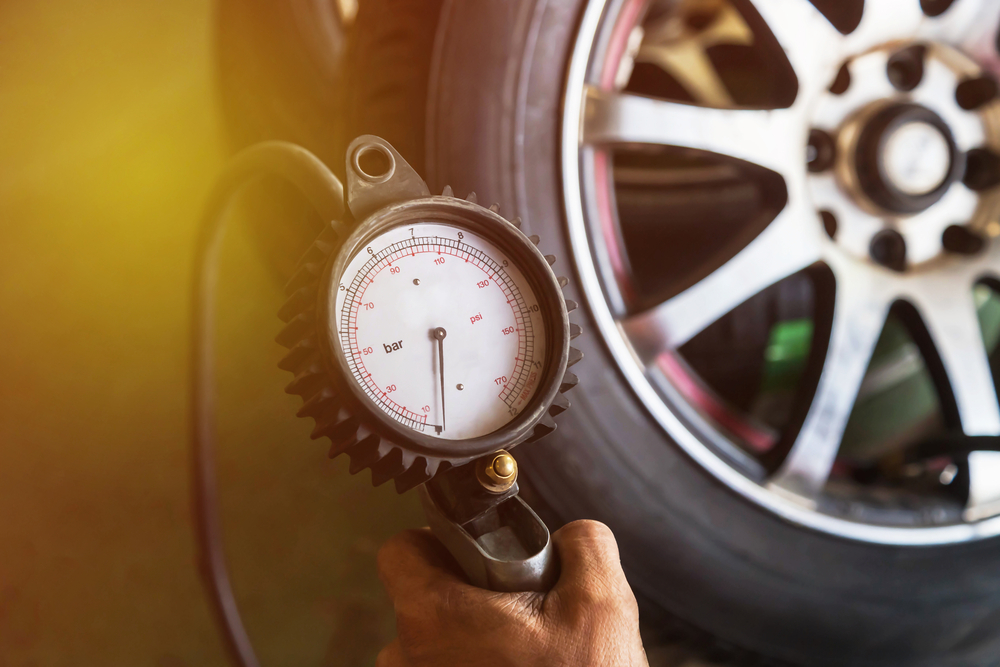Ultimate Guide To Pneumatic Tires
Posted by: admin on July 31, 2022
 Selecting the right tool for the job can make all the difference. Choosing tires for your forklift is incredibly important. Pneumatic tires are ideal for outdoor use – they stand up well in the face of uneven terrain. Cushion tires have their benefits, too. By understanding the differences between these types of forklift tires, you can make the best decision for the task at hand.
Selecting the right tool for the job can make all the difference. Choosing tires for your forklift is incredibly important. Pneumatic tires are ideal for outdoor use – they stand up well in the face of uneven terrain. Cushion tires have their benefits, too. By understanding the differences between these types of forklift tires, you can make the best decision for the task at hand.
Learning about different types of forklift tires can help make you a more informed lift operator. Of course, training can shed even more light on how such decisions impact overall safety and handling. If you’re intrigued by what you read about pneumatic tires, forklift operator training may benefit you significantly.
What Are Pneumatic Tires?
You might be wondering: what are pneumatic tires, anyway? Pneumatic tires replicate the look and feel of car and truck tires and are often used outdoors. A pneumatic tire consists of a wheel with a metal hub and a rubber tire mounted to it. The tire is filled with air or foam to a specified pressure level. This allows the tire to handle an appropriate load and perform well on different types of terrain.
There are two main types of pneumatic tires. Air pneumatics are filled with air. Solid pneumatics are puncture-proof, and made of rubber. If you’re working on a job site that’s littered with rocks, nails, and other sharp objects, solid pneumatic tires are your best bet.
What Are the Advantages of Using Pneumatic Forklift Tires?
Pneumatic forklift tires offer a number of benefits including:
✓ Outstanding Shock Absorption: The tires help forklift operators handle bumps, potholes, and other road hazards without causing a load tip-over.
✓ Ability to Use Both Off-Road and On-Pavement: The pneumatic tires can handle off-road and on-pavement applications. So, if operators need to use forklifts at worksites where they will need to drive both off-road and on-pavement, these tires can be ideal.
✓ Limited Noise: Pneumatic forklift tires tend to produce little to no noise, since they have soft rubber tread and possess shock-absorbing capabilities.
✓ No Damage to Flooring: When used indoors, the tires can protect your floors against scratches and other damage.
✓ Enhanced Maneuverability: The tires offer superior ground clearance over other options. They can make it easy to maneuver a forklift on gravel and other rough surfaces.
Most pneumatic tires are air-filled. However, some are made with solid rubber wrapped around a steel band. The solid type is designed to withstand nail punctures and other sharp objects. This makes the tires ideal for work areas that have a lot of debris on the ground, such as a construction site or lumber yard.
What Are the Disadvantages of Using Pneumatic Tires on a Forklift?
Pneumatic forklift tires require a larger frame than cushion tires. As a result, they tend to cost more. However, their ability to work on a variety of surfaces justifies the higher price.
There is also the maintenance of pneumatic tires that needs to be considered. The pressure of these tires must be monitored regularly. If the tires are damaged or punctured in any way and the pressure falls below the recommended level, they can quickly go flat. This is a real concern when working on rough terrain.
To alleviate maintenance concerns, certain pneumatic forklift tires can be inflated with polyurethane foam. In this instance, the tires won’t go flat. But, the use of polyurethane foam can reduce some of the tires’ shock-absorbing effects.
What Are Cushion Tires?
Pneumatic tires aren’t right for every work environment. That’s where cusion tires come into play. Cushion tire forklift options can be used indoors or on smooth surfaces. A small turning radius makes these types of tires ideal for narrow aisles in warehouses, manufacturing plants, loading docks, and distribution centers. Cushion tires can also be used outdoors on asphalt, but only for light applications.
Pneumatic vs. Cushion Tires
 When weighing the use of forklift cushion tires vs. pneumatic tires, application is everything. Forklift cushion tires contain more rubber than pneumatic ones, which provides the operator with a safe, comfortable ride. The extra rubber also contributes to a long service life for cushion tires. Meanwhile, these tires fit into a small frame, which can make it easy for an operator to maneuver their lift. In a warehouse, this allows a forklift driver to seamlessly navigate narrow aisles. In turn, warehouse racking can be placed close together to increase storage capacity.
When weighing the use of forklift cushion tires vs. pneumatic tires, application is everything. Forklift cushion tires contain more rubber than pneumatic ones, which provides the operator with a safe, comfortable ride. The extra rubber also contributes to a long service life for cushion tires. Meanwhile, these tires fit into a small frame, which can make it easy for an operator to maneuver their lift. In a warehouse, this allows a forklift driver to seamlessly navigate narrow aisles. In turn, warehouse racking can be placed close together to increase storage capacity.
Furthermore, cushion forklift tires are made with smooth, solid rubber that fits around a metal band. They tend to be smaller than pneumatic forklift tires and cost less. They’re also easier to maintain than pneumatic tires. Yet, their traction is inferior to that of pneumatic tires, especially when used outdoors.
Keep in mind that cushion and pneumatic tires require different frames, too. This means the tires can’t be switched out for one another.
What Is the Best Forklift Tire Option: Pneumatic or Cushion?
Before you purchase or rent a lift, be sure to consider the pros and cons of cushion vs. pneumatic tire forklifts. Factor in how you plan to use the lift and how much space you have to store it when not in use. Also consider weather the lift will be used indoors, outdoors, or in both environments. Smooth and uneven terrain can make a big difference, too. If you know you’ll be working on especially rough terrain, consider flat free tires for your forklift. By understanding the differences between these types of forklift tires, you can make the most informed decision possible.
Don’t forget tread style, either – no matter which type of tire you select, tread style should also play a factor in your decision.
Smooth vs. Traction Forklift Tire Tread Styles
Once you have the right type of tire for your forklift, you still have options in terms of tread styles. These include:
- Smooth: Best for dry indoor applications and all-steer axles.
- Traction: Work well in a variety of indoor and outdoor applications.
- Grooved: Typically used with large-capacity trucks with large loads and extreme operating conditions.
- Wide-Track: Designed for all-season use, indoors or outdoors.
Traction tires are the best choice for wet surfaces, especially indoors. When using a cushion tire forklift outside, traction tires grip the surface better and help reduce tire “chunking.” This occurs when pieces of tread fall off the tire due to overheating. Never use traction tread tires on ramps with metal teeth, as severe damage can result.
Smooth forklift tires tend to last longer than traction tires. They are easy to maintain, and the risk of puncture is low. Smooth tires are also better for the environment. Because they are often used with battery-powered forklifts, they produce no harmful emissions. These forklifts are also quieter to operate than propane or diesel forklifts.
Proper Maintenance for Pneumatic and Cushion Forklift Tires
Whether you prefer a cushion tire or a pneumatic tire, be sure to perform the following maintenance duties:
 Keep up with recommended manufacturer maintenance checks.
Keep up with recommended manufacturer maintenance checks.- Perform regular tire inspections.
- Conduct regular visual pre-check and pre-shift driving tests.
- Pay attention to floor hazards (debris, liquids, etc.) that compromise forklift tire safety.
Forklift tire “don’ts” are just as important, too. Be sure to avoid:
- Skip regularly scheduled maintenance.
- Ignore telltale signs of tire wear (worn treads, unsafe braking, etc.).
- Wait to inflate pneumatic forklift tires.
- Allow workers to operate a forklift without OSHA-compliant training.
Forklift Tire Safety Tips
You need to prioritize forklift safety, particularly when it comes to cushion and pneumatic tires. Remember, properly maintained tires are vital to safe operation of a forklift. If you teach your workers how to identify tire problems and provide them with other forklift safety tips, you can improve on-the-job safety at any worksite, at any time.
As with any forklift tires, forklift cushion and pneumatic tires should be well-maintained and have enough tread at all times. When a tire has worn away 40% or more of the tread, the forklift and the driver will absorb 84% of the shock on a rough surface. Worn tires also cause the forklift transmission to work harder to turn the tires. This can lead to accidents and costly breakdowns.
Damaged or worn out tires threaten the safety of the machine and the operator. Look for these signs:
- Damage that appears less than 1 in. from the lettering to the top of the tires
- Tires look worn down to the visible safety line
- Clear signs of chunking, tearing, or cracking
- Flat spots on the tire
Don’t forget another critical safety feature – training and certification for your forklift operators!
Learn More About Pneumatic Tires with CertifyMe
The right tools for the job really can make all the difference in terms of effectiveness. If you’re eager to learn more about pneumatic tires and other factors that play a role in the use of forklifts, sign up for certification training with CertifyMe.net. Our OSHA-approved courses are the convenient, affordable way to educate workers about forklift tire safety. Register your company today!
From common sense maintenance for pneumatic forklift tires and forklift cushion tires to proper operating techniques to hands-on evaluation, no other online training source gives you the value, complete OSHA compliance, and lifetime support of CertifyMe.net.
If you have any questions about our training packages, forklift tires, or anything else, contact us online or call our forklift safety experts at 1-888-699-4800.
Welcome to CertifyMe.net
CertifyMe.net has offered online forklift certification since 1999. With Our Convenient online program. your employess can earn their certification in an hour or less.
Browse Online Certifications:
This low-cost program can be compeleted anytime, anywhere!






